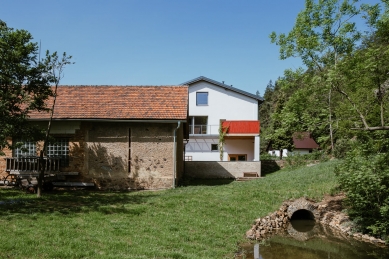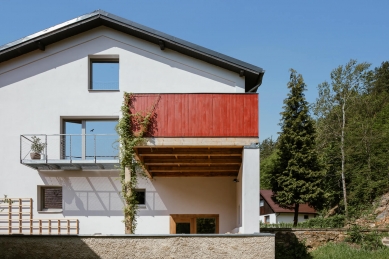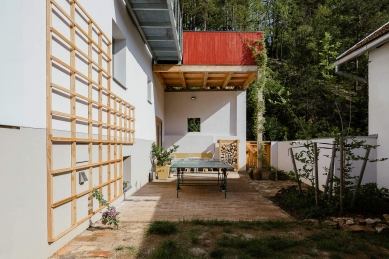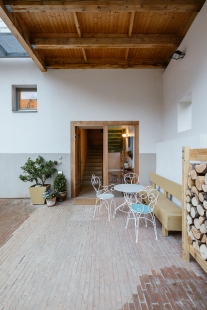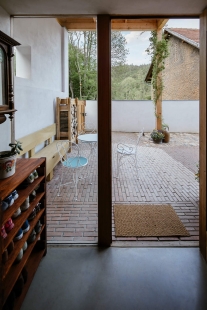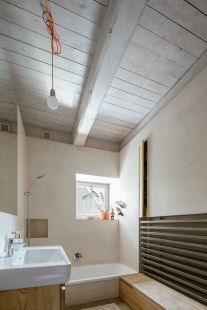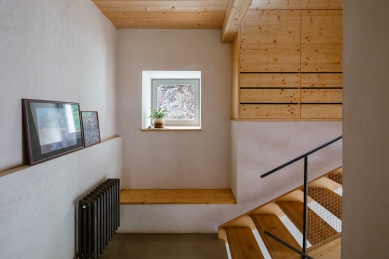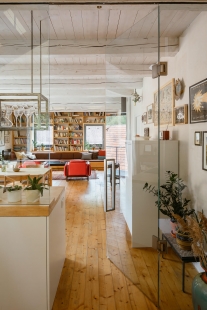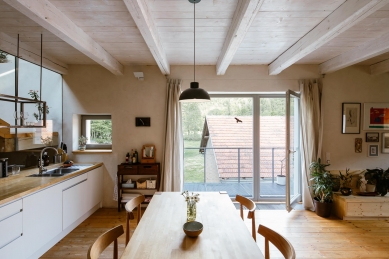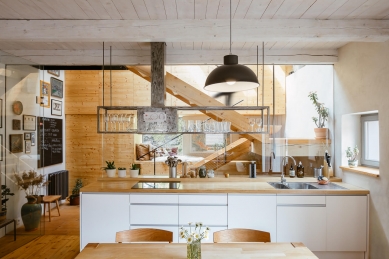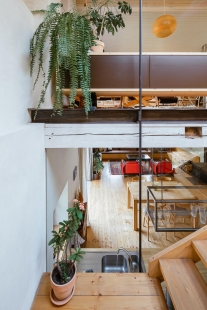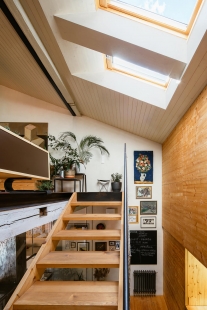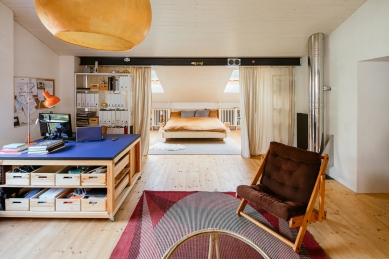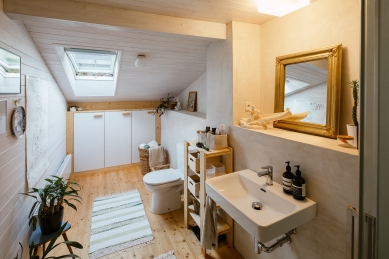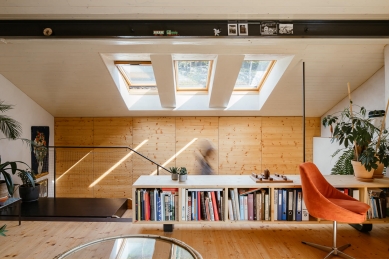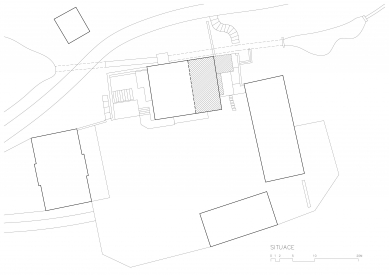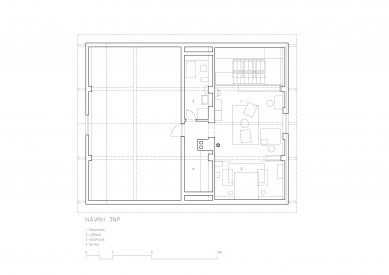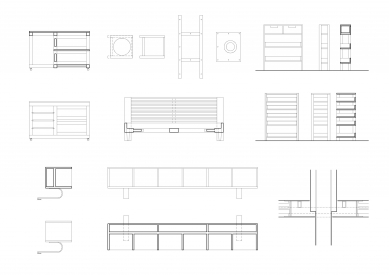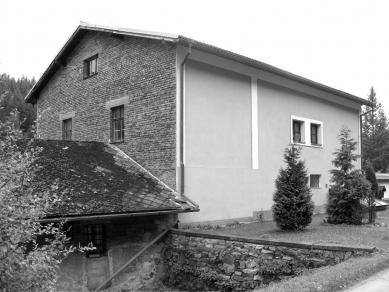
Architect's living in a watermill

The eastern part of the building of the watermill - western part of which has already been used for living since the 1990s - has been offered to the architect and his family. The newly formed generous living unit preserves the industrial character of the object and has a strongly vertical articulation with open spaces on each floor, which are interconnected by a skylight-lit staircase with inhabitable features. Main additions to the eastern façade are large windows and a terrace with a metal bridge that simultaneously covers the entrance space of the yard, embodying the esprit of sala terrena.
The starting point for his own living of the architect was a partially renovated watermill building, a former paper factory, found in the preserve in Křivoklátsko, in the valley of Zbiroh stream. The opportunity to habitate the smaller part of the building was only viable under the condition that the outer character would respect the earlier renovation.
The mill room itself essentially functions as a "two-in-one" house. The inner vertical dividing wall, which up until the addition in the 1940s was in fact the gable wall, separates the new living unit from the older one, which houses the architect's wife's parents. The units are for practical reasons interconnected via souterrain and on the second floor, without compromising privacy.
From the beginning, the main intent was to follow through with the industrial character of the building, mainly by preserving the large open spaces with original timber beam constructions on each floor. The individual floors fulfil the function of a children's room with a dressing room and a bathroom on the slightly elevated ground floor, a living room with a kitchen on the first floor and a bedroom, a study and a bathroom in the attic. In the souterrain there is a studio space, a sauna and a technical room.
The space designated for renovation is more reminiscent of a tower than a house. Given such prominent vertical arrangement of the space, the skylight-lit staircase serves as the main integrating tool.
The mentioned staircase is situated at the northern façade, and is, in the upward direction, increasingly brighter and increasingly more connected to the individual floors. On the ground floor, the staircase is completely separated from all living spaces by thick walls, on the next floor it is more interconnected thanks to a glass partition and on the last floor, the staircase naturally merges into the attic study which looks like an open deck. The motive of the design is a journey towards the skylight, as well as maximising the inhabitation possibilities of the staircase.
Exterior modifications are focused mainly at the eastern gable façade, which has been prominently modified. Large windows have been added, as well as a terrace at the same level the kitchen is situated. The terrace is accessible by an interconnecting bridge and offers enchanting views of a small rockery and the open valley of the Zbiroh stream. The erection of the terrace has also enabled the roofing of the entrance area, which serves as the traditional "doorstep" space. Given the slight elevation of the ground floor, the terrace is quite high up above the yard ground and its scale - when viewed from the entrance - evokes an open sala terrena, merging the space on the outside of the settlement into a safe fortress. Both opposite positions of the form correspond with the tall and voluminous building. On the northern façade, two new smaller openings have been added in order to bring light into the staircase, the southern façade has then been left more or less intact, in order to respect the wishes of the parents - only one windowsill had to be slightly elevated.
The design has preserved the industrial and at the same time rural character of the exterior as well as the interior. Material-wise, mainly wood, metal, stucco plastering and cement coating have been used. The building has been treated with regards to ecology and with the effort of maximal utilisation of all that already existed. All wood as well as timber beams from the original structure, as well as all other gathered timber that has accumulated over the years in the settlement have been used not only as construction members but also in the interior. Recycled wood has, for example, been used to construct the terrace, or as furniture in the bathroom and much more.
Other than a few exceptions such as the kitchen counter, the interior has been furnished mainly with furniture from the era of the 1950s up until the 1980s or any other original furniture form natural materials. The style of the author and particular care have been applied to the today often understated furnishing fabrics. The main living space is dominated by an original carpet, which is a piece that emerged from the collaboration of a textile artist and the architect's wife. The colours of the woven carpet also take into account the textiles used for all the seating furniture that has been integrated with the custom designed bookshelf. This piece of furniture is then aligned all the way along the southern wall and has been designed in such manner that all generations living in the settlement could meet here and that friends could perhaps stay overnight. Furthermore, a bold tapestry has been hung in the space above the staircase. The furniture and the lighting appliances from the golden era of Czech deign in the study have been accompanied by a rug by Antonin Kybal. Paintings by Vilem Balej also pay a crucial role in the interior, as he is the architect's friend from their student years.
The starting point for his own living of the architect was a partially renovated watermill building, a former paper factory, found in the preserve in Křivoklátsko, in the valley of Zbiroh stream. The opportunity to habitate the smaller part of the building was only viable under the condition that the outer character would respect the earlier renovation.
The mill room itself essentially functions as a "two-in-one" house. The inner vertical dividing wall, which up until the addition in the 1940s was in fact the gable wall, separates the new living unit from the older one, which houses the architect's wife's parents. The units are for practical reasons interconnected via souterrain and on the second floor, without compromising privacy.
From the beginning, the main intent was to follow through with the industrial character of the building, mainly by preserving the large open spaces with original timber beam constructions on each floor. The individual floors fulfil the function of a children's room with a dressing room and a bathroom on the slightly elevated ground floor, a living room with a kitchen on the first floor and a bedroom, a study and a bathroom in the attic. In the souterrain there is a studio space, a sauna and a technical room.
The space designated for renovation is more reminiscent of a tower than a house. Given such prominent vertical arrangement of the space, the skylight-lit staircase serves as the main integrating tool.
The mentioned staircase is situated at the northern façade, and is, in the upward direction, increasingly brighter and increasingly more connected to the individual floors. On the ground floor, the staircase is completely separated from all living spaces by thick walls, on the next floor it is more interconnected thanks to a glass partition and on the last floor, the staircase naturally merges into the attic study which looks like an open deck. The motive of the design is a journey towards the skylight, as well as maximising the inhabitation possibilities of the staircase.
Exterior modifications are focused mainly at the eastern gable façade, which has been prominently modified. Large windows have been added, as well as a terrace at the same level the kitchen is situated. The terrace is accessible by an interconnecting bridge and offers enchanting views of a small rockery and the open valley of the Zbiroh stream. The erection of the terrace has also enabled the roofing of the entrance area, which serves as the traditional "doorstep" space. Given the slight elevation of the ground floor, the terrace is quite high up above the yard ground and its scale - when viewed from the entrance - evokes an open sala terrena, merging the space on the outside of the settlement into a safe fortress. Both opposite positions of the form correspond with the tall and voluminous building. On the northern façade, two new smaller openings have been added in order to bring light into the staircase, the southern façade has then been left more or less intact, in order to respect the wishes of the parents - only one windowsill had to be slightly elevated.
The design has preserved the industrial and at the same time rural character of the exterior as well as the interior. Material-wise, mainly wood, metal, stucco plastering and cement coating have been used. The building has been treated with regards to ecology and with the effort of maximal utilisation of all that already existed. All wood as well as timber beams from the original structure, as well as all other gathered timber that has accumulated over the years in the settlement have been used not only as construction members but also in the interior. Recycled wood has, for example, been used to construct the terrace, or as furniture in the bathroom and much more.
Other than a few exceptions such as the kitchen counter, the interior has been furnished mainly with furniture from the era of the 1950s up until the 1980s or any other original furniture form natural materials. The style of the author and particular care have been applied to the today often understated furnishing fabrics. The main living space is dominated by an original carpet, which is a piece that emerged from the collaboration of a textile artist and the architect's wife. The colours of the woven carpet also take into account the textiles used for all the seating furniture that has been integrated with the custom designed bookshelf. This piece of furniture is then aligned all the way along the southern wall and has been designed in such manner that all generations living in the settlement could meet here and that friends could perhaps stay overnight. Furthermore, a bold tapestry has been hung in the space above the staircase. The furniture and the lighting appliances from the golden era of Czech deign in the study have been accompanied by a rug by Antonin Kybal. Paintings by Vilem Balej also pay a crucial role in the interior, as he is the architect's friend from their student years.
0 comments
add comment


